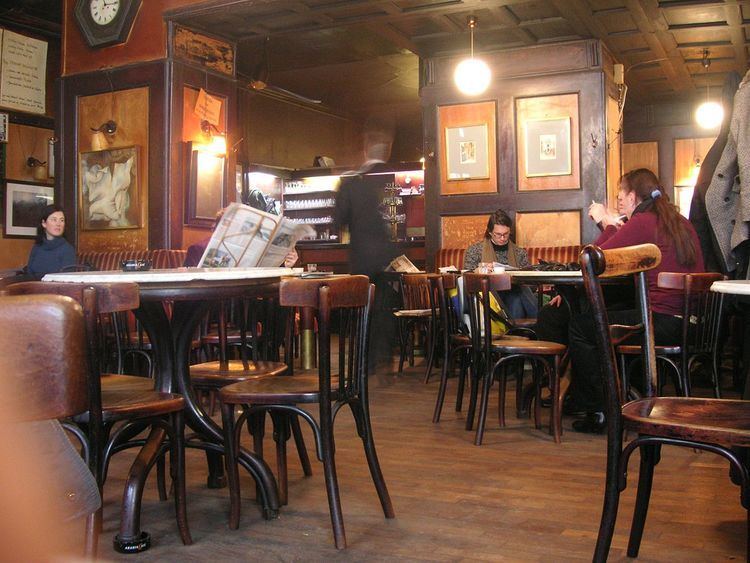 | ||
The Viennese coffee house (German: Wiener Kaffeehaus) is a typical institution of Vienna that played an important part in shaping Viennese culture.
Contents
Since October 2011 the "Viennese Coffee House Culture" is listed as "Intangible Cultural Heritage" in the Austrian inventory of the "National Agency for the Intangible Cultural Heritage", a part of UNESCO. The Viennese coffee house is described in this inventory as a place "where time and space are consumed, but only the coffee is found on the bill."
Viennese coffee house culture
The social practices, the rituals, the elegance create the very specific atmosphere of the Viennese café. Coffee Houses entice with a wide variety of coffee drinks, international newspapers, and pastry creations. Typical for Viennese Coffee Houses are marble tabletops, Thonet chairs, newspaper tables and interior design details in the style of Historicism. The Austrian writer Stefan Zweig described the Viennese Coffee House as an institution of a special kind, "actually a sort of democratic club, open to everyone for the price of a cheap cup of coffee, where every guest can sit for hours with this little offering, to talk, write, play cards, receive post, and above all consume an unlimited number of newspapers and journals." Zweig in fact attributed a good measure of Vienna's cosmopolitan air to the rich daily diet of current and international information offered in the coffee houses.
In many classic cafés (for example Café Central and Café Prückel) piano music is played in the evening and social events like literary readings are held. In warmer months, customers can often sit outside in a Schanigarten. Almost all coffee houses provide small food dishes like sausages as well as desserts, cakes and tarts, like Apfelstrudel, Millirahmstrudel, Punschkrapfen and Linzer torte.
Unlike some other café traditions around the world, it is completely normal for a customer to linger alone for hours and study the omnipresent newspaper. Along with coffee, the waiter will serve an obligatory glass of cold tap water and during a long stay will often bring additional water unrequested, with the idea to serve the guest with an exemplary sense of attention.
In the late 19th and early 20th century, leading writers of the time became attached to the atmosphere of Viennese cafés and were frequently seen to meet, exchange and to even write there. Literature composed in cafés is commonly referred to as coffee house literature, the writers thereof as coffee house poets. The famous journal Die Fackel ("The Torch") by Karl Kraus is said to have been written in cafés to a large extent. Other coffee house poets include Arthur Schnitzler, Alfred Polgar, Friedrich Torberg, and Egon Erwin Kisch. Famous writer and poet Peter Altenberg even had his mail delivered to his favorite café, the Café Central.
History
Legend has it that soldiers of the Polish-Habsburg army, while liberating Vienna from the second Turkish siege in 1683, found a number of sacks with strange beans that they initially thought were camel feed and wanted to burn. The Polish king Jan III Sobieski granted the sacks to one of his officers named Jerzy Franciszek Kulczycki, who started the first coffee house. This story was published by the Catholic Priest Gottfried Uhlich in 1783 in his History of the second Turkish Siege, and he took some liberties. In reality, Kulczycki's coffee house missed being the first by more than a year. A more factual account has been reported by Karl Teply.
After some experimentation, the legend goes on, Kulczycki added some sugar and milk, and the Viennese coffee tradition was born. This achievement has been recognized in many modern Viennese coffeehouses by hanging a picture of Kulczycki in the window. Another account is that Kulczycki, having spent two years in Ottoman captivity, knew perfectly well what coffee really was and tricked his superiors into granting him the beans that were considered worthless.
According to recent research, Vienna's first coffee house was in fact opened by an Armenian businessman named Johannes Diodato in 1685. 15 years later, four Greek owned coffeehouses had the privilege to serve coffee.
The new drink was well received, and coffee houses began to pop up rapidly. In the early period, the various drinks had no names, and customers would select the mixtures from a colour-shaded chart.
The heyday of the coffee house was the turn of the nineteenth century when writers like Peter Altenberg, Alfred Polgar, Karl Kraus, Hermann Broch and Friedrich Torberg made them their preferred place of work and pleasure. Many famous artists, scientists, and politicians of the period such as Arthur Schnitzler, Stefan Zweig, Egon Schiele, Gustav Klimt, Adolf Loos, Theodor Herzl, Alfred Adler, and even Leon Trotsky were constant coffee house patrons. In Prague, Budapest, Cracow, and Lviv (Lemberg) and other cities of the Austro-Hungarian empire there were also many coffee houses according to the Viennese model.
In the 1950s, the period of "coffee house death" began, as many famous Viennese coffee houses had to close. This was due to the popularity of television and the appearance of modern espresso bars. Nevertheless, many of these classic Viennese coffee houses still exist. A renewed interest in their tradition and tourism have prompted a comeback.
